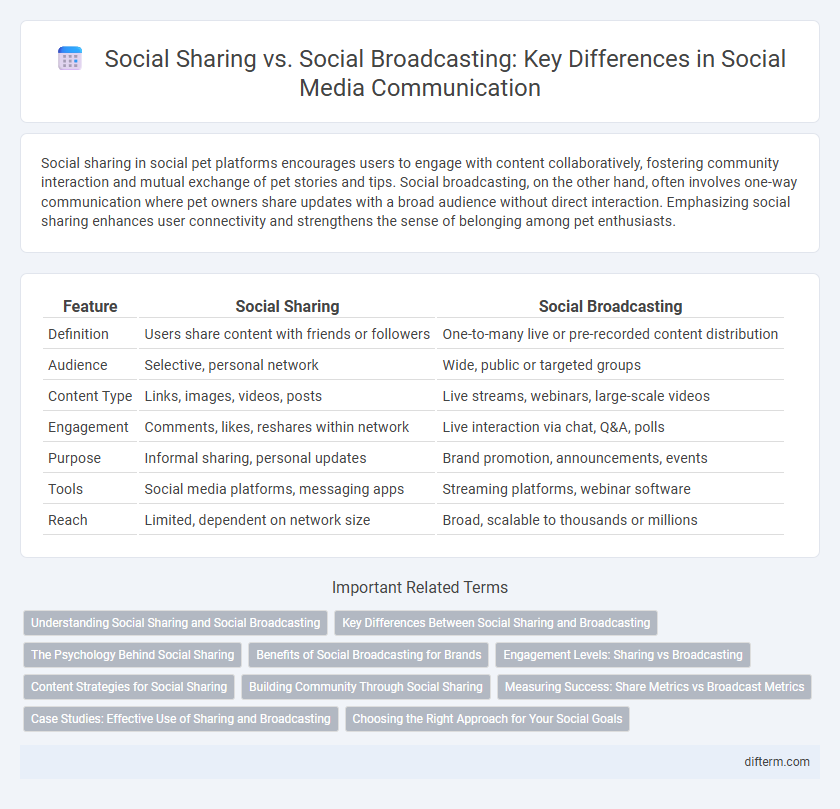Social sharing in social pet platforms encourages users to engage with content collaboratively, fostering community interaction and mutual exchange of pet stories and tips. Social broadcasting, on the other hand, often involves one-way communication where pet owners share updates with a broad audience without direct interaction. Emphasizing social sharing enhances user connectivity and strengthens the sense of belonging among pet enthusiasts.
Table of Comparison
| Feature | Social Sharing | Social Broadcasting |
|---|---|---|
| Definition | Users share content with friends or followers | One-to-many live or pre-recorded content distribution |
| Audience | Selective, personal network | Wide, public or targeted groups |
| Content Type | Links, images, videos, posts | Live streams, webinars, large-scale videos |
| Engagement | Comments, likes, reshares within network | Live interaction via chat, Q&A, polls |
| Purpose | Informal sharing, personal updates | Brand promotion, announcements, events |
| Tools | Social media platforms, messaging apps | Streaming platforms, webinar software |
| Reach | Limited, dependent on network size | Broad, scalable to thousands or millions |
Understanding Social Sharing and Social Broadcasting
Social sharing involves individuals distributing content within their personal networks to foster authentic engagement and build community trust. Social broadcasting refers to the wide dissemination of messages across large audiences using platforms like Facebook Live or Twitter, aiming for extensive reach and real-time interaction. Understanding the differences helps marketers choose between personal influence and broad visibility to optimize campaign effectiveness.
Key Differences Between Social Sharing and Broadcasting
Social sharing involves individuals distributing content within their personal networks, promoting interaction, engagement, and personalized communication. Social broadcasting, by contrast, targets a broad audience with one-to-many communication, often originating from brands or influencers aiming for maximum reach and visibility. The key differences lie in audience size, communication style, and the level of engagement, with sharing fostering two-way interactions and broadcasting emphasizing mass exposure.
The Psychology Behind Social Sharing
Social sharing engages individuals by tapping into intrinsic motivations such as identity expression, social approval, and emotional connection, driving users to distribute content that resonates personally. In contrast, social broadcasting caters to a broader, less personalized audience, often prioritizing volume over meaningful interaction, which can dilute the psychological impact on recipients. Understanding these psychological drivers reveals why targeted social sharing fosters deeper trust and community engagement compared to the more impersonal nature of social broadcasting.
Benefits of Social Broadcasting for Brands
Social broadcasting empowers brands to reach vast, diverse audiences in real time, enabling authentic engagement and instantaneous feedback. It amplifies brand visibility and trust by creating immersive, interactive experiences that foster community and loyalty. Leveraging platforms like Instagram Live or Facebook Live, brands drive higher conversion rates through dynamic storytelling and personalized content delivery.
Engagement Levels: Sharing vs Broadcasting
Social sharing generates higher engagement levels by fostering direct interactions and personal connections through content shared among users' networks. Social broadcasting tends to produce lower engagement as it involves one-way communication, limiting opportunities for dialogue and feedback from the audience. Platforms emphasizing social sharing features report increased user retention and interaction rates compared to those prioritizing broad, one-to-many communication.
Content Strategies for Social Sharing
Content strategies for social sharing prioritize creating engaging, authentic, and relatable posts that encourage user interaction and organic dissemination. Leveraging user-generated content, personalized messages, and interactive formats like polls or stories increases shareability and fosters community growth. Emphasizing value-driven content that resonates emotionally motivates audiences to share, amplifying reach without relying on broad social broadcasting tactics.
Building Community Through Social Sharing
Social sharing fosters authentic connections by encouraging users to exchange personal experiences and insights, creating a sense of belonging and trust within the community. This participatory approach contrasts with social broadcasting, which typically involves one-way communication that limits engagement and diminishes community cohesion. Emphasizing interactive content and peer-to-peer dialogue through social sharing amplifies collective identity and strengthens long-term community growth.
Measuring Success: Share Metrics vs Broadcast Metrics
Social sharing measures success through metrics like engagement rate, shares, and user interactions, reflecting audience involvement and content resonance. Social broadcasting success is evaluated by reach, impressions, and viewer retention, emphasizing content exposure and audience size. Comparing share metrics and broadcast metrics highlights the distinction between active participation and passive consumption in social media strategies.
Case Studies: Effective Use of Sharing and Broadcasting
Case studies reveal that social sharing enhances community engagement by fostering authentic interactions and user-generated content, leading to increased brand loyalty and word-of-mouth referrals. Social broadcasting proves effective in reaching large audiences quickly with consistent messaging, driving brand awareness and event promotion. Combining both strategies allows businesses to optimize reach and deepen audience connection through targeted campaigns.
Choosing the Right Approach for Your Social Goals
Social sharing emphasizes personalized content distribution within smaller, trusted networks, fostering genuine engagement and stronger community connections. Social broadcasting targets a wide audience through mass communication channels, ideal for brand awareness and promotional campaigns. Selecting the right approach depends on your specific social goals, with sharing enhancing trust and interaction, while broadcasting maximizes reach and visibility.
social sharing vs social broadcasting Infographic

 difterm.com
difterm.com